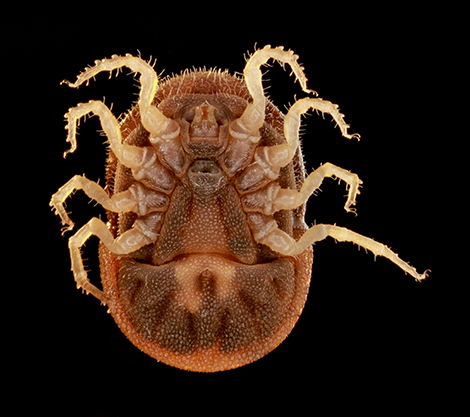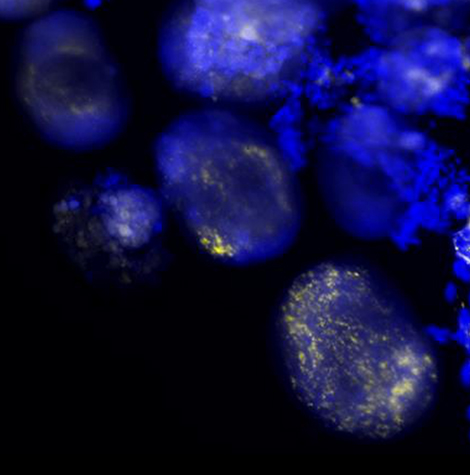Global S&T Development Trend Analysis Platform of Resources and Environment
| Bacteria ensure square meal for bloodsucking ticks | |
| admin | |
| 2018-05-31 | |
| 发布年 | 2018 |
| 语种 | 英语 |
| 国家 | 法国 |
| 领域 | 地球科学 |
| 正文(英文) | How do ticks live solely on blood? A study presented in Current Biology (May 31, 2018) has elucidated the crucial role played by symbiotic bacteria that synthesize B vitamins. These nutrients are scarcely found in the blood ticks ingest but are essential to their life cycle. Thus ticks cannot survive to adulthood or reproduce without their bacterial symbionts. The study conducted by CNRS and CIRAD researchers has also shown that the bacteria inherited their B vitamin synthesis pathways from a pathogenic ancestor whose genome underwent gradual degradation.
Ticks are major pathogenic vectors and especially well known for the part they play in spreading Lyme and other emerging diseases. Unlike mosquitoes, ticks are strictly hematophagousthat is, they feed exclusively on blood at all stages in their development. But there is a consequence of having such a highly specialized diet. Though blood is rich in some nutrients, it is relatively poor in others, like B vitamins. One hypothesis has offered a solution to the puzzle presented by this unique mode of nutrition: as ticks cannot satisfy vitamin requirements from their blood meals, perhaps bacteria synthesize these compounds for them.
To explain how ticks have adapted to blood-only diets, scientists from the MIVEGEC (CNRS / IRD / University of Montpellier) and ASTRE (CIRAD / INRA / University of Montpellier)1 research units have examined the microbial communities they harbor. They discovered that a symbiotic bacterium of the genus Francisella is a predominant constituent of the microbial community hosted by the African soft tick (Ornithodoros moubata), a model species. Complete sequencing of the bacterium's genome has confirmed it can produce various B vitamins: biotin (vitamin H), riboflavin (vitamin B2), and folic acid (vitamin Bc). By showing that ticks deprived of the bacterium cease development but resume normal growth upon supplementation with vitamins the microorganism would provide, the researchers demonstrated the role of Francisella in tick nutrition. Additional analyses made it possible to identify the evolutionary origin of the nutritional symbiosis. Symbiotic Francisella descend from pathogenic bacteria whose genome suffered extensive degradation. This left intact only a subset of their original functional traits, including synthesis of the three mentioned B vitamins. The first appearance of ticks and their later diversificationover 900 species are currently knownwere largely conditioned by this symbiosis. The process underscores the important contribution of microorganisms to the ecological diversity of animals and the evolution of new diets.  © F. Thiaucourt Ventral view of soft tick Ornithodoros moubata infected by symbiotic bacterium of genus Francisella.  © Marie Buysse, laboratoire Mivegec (CNRS/IRD/Université de Montpellier). Micrograph of oocytes (shown in blue) of the soft tick Ornithodoros moubata. Presence of symbiotic Francisella (shown in yellow) within oocytes is here revealed by fluorescence Download the press release :  Notes:1 This research also involved scientists from the LBBE research unit (CNRS / Claude Bernard Lyon 1 University / VetAgro Sup), the IBMM (CNRS / University of Montpellier / ENSCM), and the INRA Get-PlaGe facility. Bibliography:Duron O, Morel O, Noël V, Buysse M, Binetruy F, Lancelot R, Loire E, Ménard C, Bouchez O, Vavre F, Vial L. Tick-bacteria mutualism depends on B vitamin synthesis pathways. Curr. Biol. 2018 May 31. DOI : 10.1016/j.cub.2018.04.038 Contacts: CNRS researcher l Olivier Duron l T (+33) (0)4 67 41 61 58 l olivier.duron@ird.fr |
| URL | 查看原文 |
| 来源平台 | Centre national de la recherche scientifique |
| 文献类型 | 新闻 |
| 条目标识符 | http://119.78.100.173/C666/handle/2XK7JSWQ/106993 |
| 专题 | 地球科学 |
| 推荐引用方式 GB/T 7714 | admin. Bacteria ensure square meal for bloodsucking ticks. 2018. |
| 条目包含的文件 | 条目无相关文件。 | |||||
| 个性服务 |
| 推荐该条目 |
| 保存到收藏夹 |
| 查看访问统计 |
| 导出为Endnote文件 |
| 谷歌学术 |
| 谷歌学术中相似的文章 |
| [admin]的文章 |
| 百度学术 |
| 百度学术中相似的文章 |
| [admin]的文章 |
| 必应学术 |
| 必应学术中相似的文章 |
| [admin]的文章 |
| 相关权益政策 |
| 暂无数据 |
| 收藏/分享 |
除非特别说明,本系统中所有内容都受版权保护,并保留所有权利。
修改评论